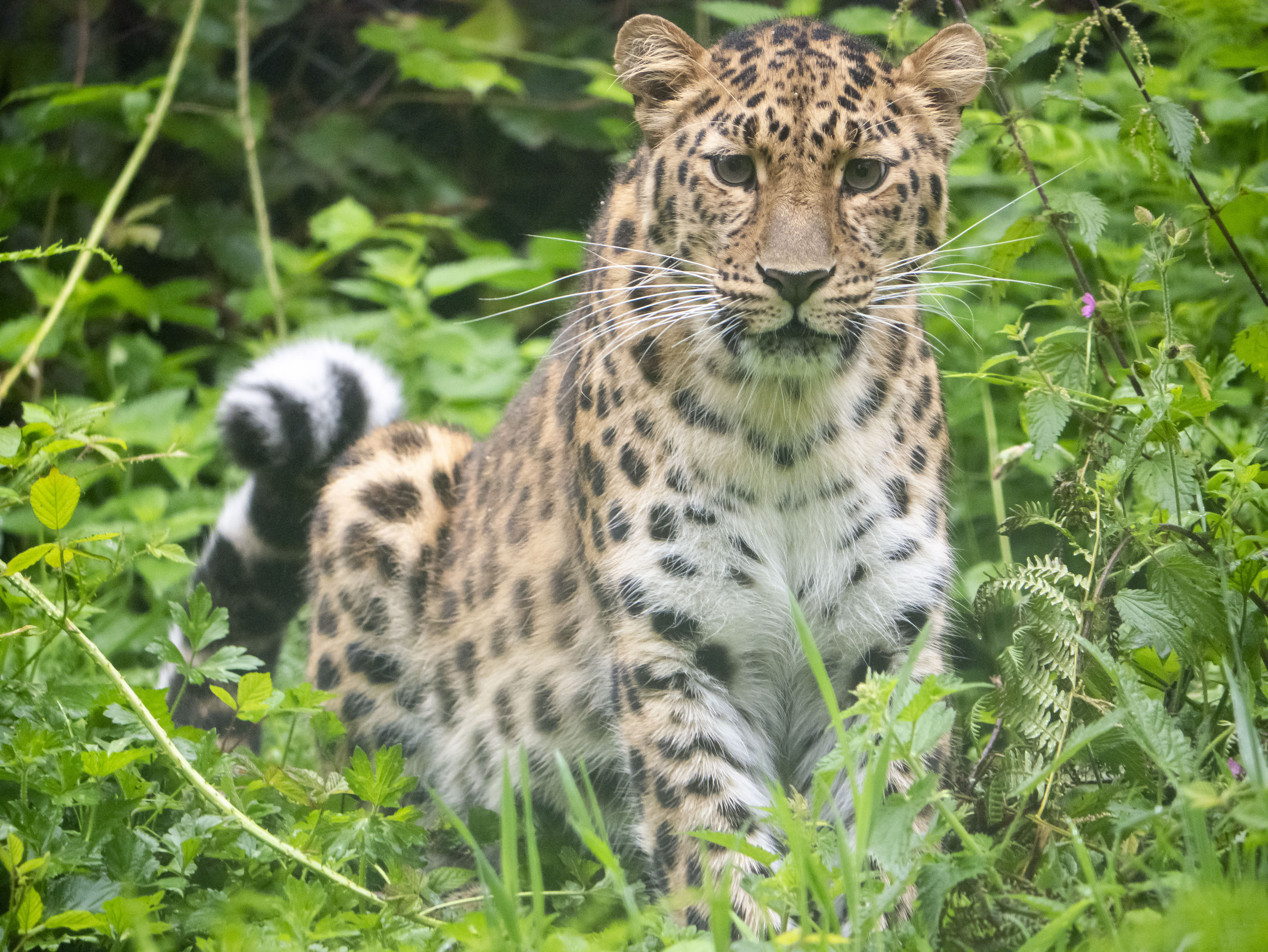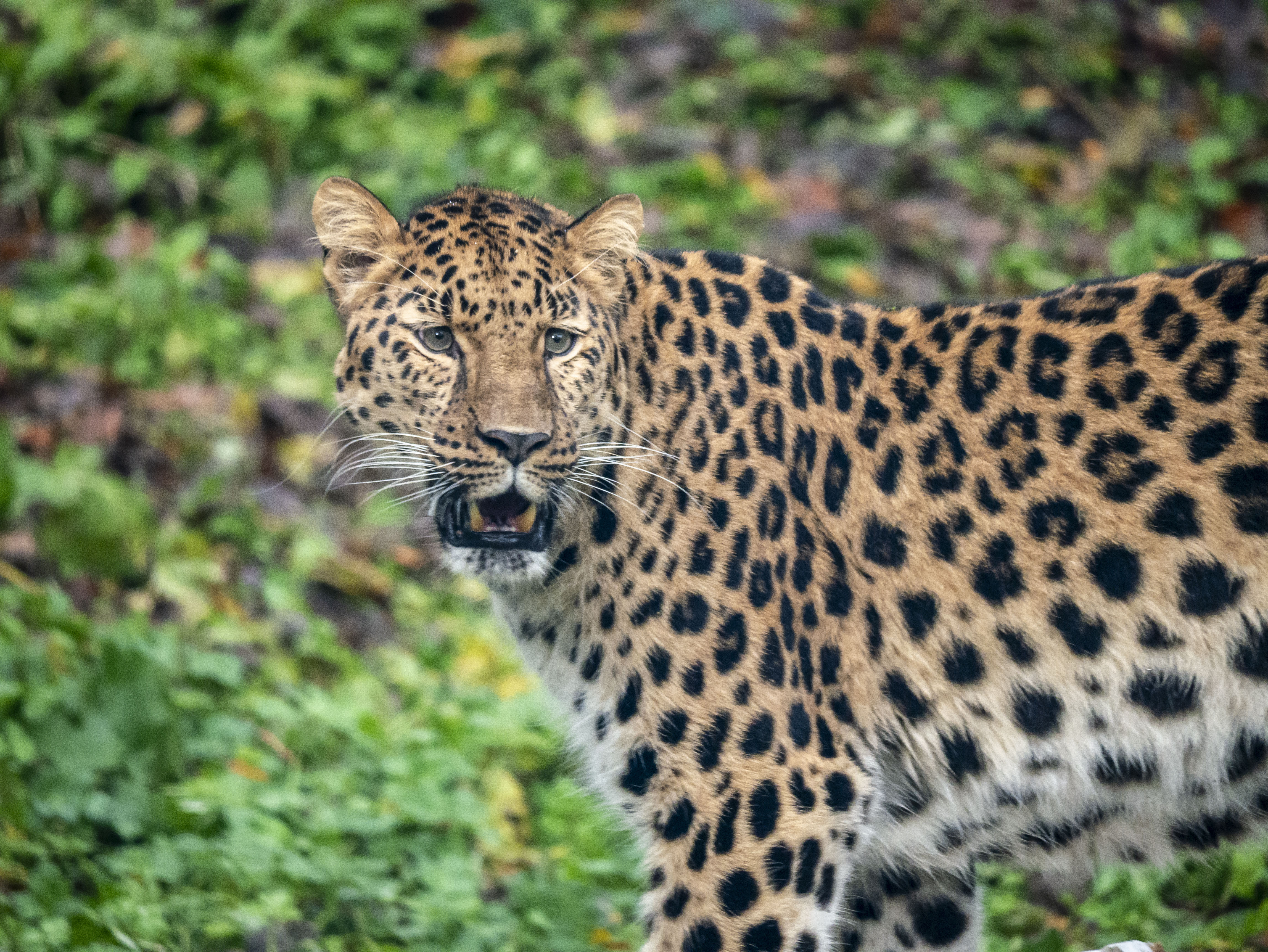There is cause for celebration at Dartmoor Zoo as Freddo and Lena, a breeding pair of the rarest big cats in the world, give birth to a Critically Endangered Amur Leopard cub.
This is a huge milestone not only for Dartmoor Zoo, but for global conservation efforts of the Critically Endangered, Amur Leopard species.
Travelling from Colchester Zoo, Lena, Freddo’s highly anticipated mate, arrived at Dartmoor Zoo in August 2024. After successful introduction on Tuesday 29th April 2025, the pair became inseparable and there were multiple observations of mutual grooming and mating soon after. Dartmoor Zoo are thrilled to announce that their first cub was born on Monday 29th September 2025. Staff were able to witness the birth via CCTV footage of the cub and mother in their cubbing den. Less than 5 weeks later the cub has begun to explore its surroundings. According to the Zoological Information Management System (ZIMS), our cub is one of only 15 Amur Leopards born globally in 2025, this is a huge milestone not only for Dartmoor Zoo, but for global conservation efforts of the Critically Endangered, Amur Leopard species.
CEO David Gibson commented: “The birth of our first Amur Leopard cub here at Dartmoor Zoo is the culmination of several years of planning and hard work. It's incredibly rewarding to know that we are making a significant contribution to the survival of the most endangered big cat in the world. With less than 400 individuals left around the world, between the wild and zoo populations, the arrival of this cub is globally important. It will be sometime yet before the cub is visible to our visitors, but they can rest assured that both mum and cub are getting the very best of care and attention in the meantime.”
Amur Leopard are regarded as the world’s rarest Big Cat with only an estimated 120 left in the wild. This number has been slowly increasing in recent years due mainly to improved legal protection and enforcement in their range countries. For this reason, the IUCN categorises the Amur Leopard as being Critically Endangered.
A large part of the funding for this conservation work comes from zoo’s and in 2024 the international zoo community contributed over $160,000 to help protect this amazing species.
Wildcats Conservation Alliance commented: “Zoos are an essential safety net for Amur leopards, the world’s rarest big cat. With only roughly 120 remaining in the wild each Amur leopard born in an accredited zoo strengthens a carefully managed breeding program which acts as a genetically diverse reservoir for future reintroductions. Zoos are also one of the main providers of conservation funding, investing more than $350 million USD annually. Through WildCats Conservation Alliance, Dartmoor Zoo is funding impact-driven conservation in the Amur leopard’s wild habitat, so this cub helps maintain the genetic safety net for future reintroduction while also driving fundraising that powers conservation on the ground.”
Although it is not currently possible to consider re-introductions of animals into the wild, maintaining a healthy growing population of Amur Leopards within the world’s zoos is essential to ensuring the continuing recovery of this enigmatic and highly secretive predator.
The Amur Leopard is one of 9 species of Leopards known to mankind. In the wild its principal prey is the Sika Deer which it hunts on densely forested valleys and mountain sides.
Amur Leopards are a cold adapted species meaning they can survive in the most challenging of conditions. Their thick coat allows them to stay active and hunt throughout the worst of the winter in the extreme North Eastern China and South Eastern Russia.
Females normally give birth to litters of up to 3 cubs at a time and in the wild they would keep the cubs hidden for the first 8 weeks of their lives to help protect them from other predators.
Wildlife Conservation Coordinator, Zoologischer Garten Berlin AG and Amur leopard EEP Coordinator Katharina Herrmann commented: “Every Amur leopard birth is a significant achievement for the survival of this critically endangered species. With only an estimated 120 individuals left in the wild, each cub born under human care represents an important step towards securing the future of one of the rarest cats on Earth. Zoos play a crucial role in this effort, because they provide a genetically healthy safety net for the wild population and offer real hope for the long-term conservation of the Amur leopard."
To replicate natural behaviours in the wild, Freddo and Lena were separated a few days before the anticipated arrival of the cub. Initial observations show that Lena seems calm, in good spirits and already showing signs of motherly intuition, whilst fenceline encounters with Freddo are positive, showing signs of interest, attentiveness and a calm demeanour towards Lena and their cub. The enclosure remains off show during this time to give the family time to adjust and announcements of when the public can view the cub will be made in due course.
Animal Manager Madeleine Millin commented: “We are absolutely delighted that our Amur Leopards have bred successfully, and a cub has been born to mother Lena and father Freddo on 29th September. It has been a rewarding journey for Lena to settle and be comfortable with her keepers and new home here at Dartmoor and for her to be happy to be introduced to Freddo our ever-steady male. They have been happily living together, enjoying each other’s company, so much so that successful mating was seen and has subsequently produced a healthy cub.
We have been following mother and cub’s progress via cameras in the cubbing den. Lena is a first-time mother and has been doing a fantastic job of caring for her little one who is now 5 ½ weeks old. She is very attentive and protective, reassuringly licking it and going to retrieve it when it wonders off too far! The cub is moving around well, playing with mum and exploring the surroundings of the den. The entire keeper team are excited and I’m very proud and can’t wait to watch the cub develop and thrive.”
This project would not have been possible or successful without the support, guidance and trust from the EEP Coordinators, our dedicated keeper team and with generous funding from one of our Trustees, Simon Almond. Dartmoor Zoo thanks everyone for their time and effort and invites everyone to celebrate a truly wonderful addition to the Dartmoor Zoo family.
Dartmoor Zoo Trustee, Simon Almond, commented: “As a founder trustee with 12 years involvement in the charity, with all the ups and downs of which there have been many, to finally reach such an exciting milestone successfully breeding one of the most endangered big cats on the planet is truly amazing. My family and I are thrilled to have had a small part in this success, but the credit is to all our amazing team and the breeding programme that believed in us.”
If you are able and willing, please donate towards more conservation projects like this, to help Dartmoor Zoo keep up the good fight!
To find out more about Dartmoor Zoo visit www.dartmoorzoo.org.uk.
Ends
Press release distributed by Pressat on behalf of Dartmoor Zoological Society, on Friday 7 November, 2025. For more information subscribe and follow https://pressat.co.uk/
Amur Leopard Critically Endangered Cub Birth Announcement Dartmoor Zoo Rarest Cat In The World Conservation Charity Charities & non-profits
Published By

01752837645
marketing@dartmoorzoo.co.uk
https://www.dartmoorzoo.org.uk/
david.gibson@dartmoorzoo.co.uk
emma.thomas@dartmoorzoo.co.uk
Visit Newsroom
You just read:
There is cause for celebration at Dartmoor Zoo as Freddo and Lena, a breeding pair of the rarest big cats in the world, give birth to a Critically Endangered Amur Leopard cub.
News from this source:



